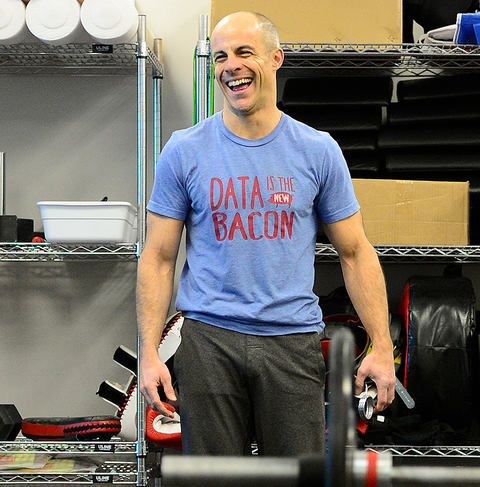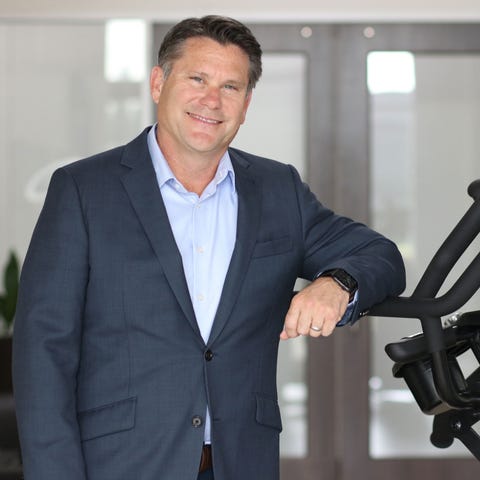From the first moment public health departments realized the Covid-19 pandemic was a real threat, just about everyone’s lifestyle was radically changed. For those who spent their their pre-pandemic time and energy committed to honing their physical fitness, this was a particularly jarring adjustment.
Gathering indoors in public and private spaces alike and exercising in close proximity to other people, once a tried-and-true method to promote healthy living, was deemed the opposite: a major health risk. To adjust, we stayed home, became more solitary, found new ways to work without equipment—the changes have been nearly innumerable.
To say that the pandemic has impacted the way we train would be an understatement—but that change affects more than just the immediate material conditions of the fitness industry. The ripple effects will be vast, upending a sector that was already on the precipice of radical transformation. “The fitness world is one of the last brick-and-mortar bastions to be truly disrupted by software, because of its innate physical aspect,” says William Allen, cofounder of venture capital firm Harpoon Ventures. “But the pandemic forced its hand.”
Surely, some remnants of the old staples of fitness culture will remain. For those fully ingrained in their habits, in-person training, group fitness, and big-box memberships aren’t just going to disappear overnight. But the adjustments we’ve all made during the pandemic are also here to stay.
Now that people have reimagined what it means to work out—and what their definition of what physical fitness actually means—the paradigm has truly begun to shift. With big business looking on and digital platforms evolving, change has come.
Here, seven innovative fitness thinkers share their vision for the future of the gym.
Take 1: Boutiques Will Thrive
Says Mark Cuban, entrepreneur and investor in many fitness brands, including Rise Nation
“Once the vaccine is widely distributed, the snapback to gyms will be big. The biggest beneficiaries will be boutique workout gyms like Rise Nation, DanceBody, SoulCycle, and the like. People will want to go where they can not only get a great workout but also socialize. The other benefit: Each machine at these single-modality gyms acts as its own ‘pod’ to avoid cross-contamination with the right capacity, cleaning, and ventilation.”
Take 2: Workouts Will Be Redefined
Says Matt Delaney, manager of innovation at Equinox
“We used to think a workout had to be 50 minutes and it had to be in a gym. But thanks to the pandemic, people are realizing that a 20-minute class on an app at home or a circuit using water jugs as weights can be a good workout for the day, but it also can’t be what you do all of the time. The gyms of the future will include digital offerings that help you do the at-home stuff better. You’ll visit to connect with the community, to use big weights and other specialized equipment and receive more tailored, in-person coaching.”
Take 3: Gyms Will Be Software Companies
Says William Allen, cofounder of Harpoon Ventures
“Gyms of the future will be software companies that perform data analytics to help us reach our goals. People will have equipment at home that connects to the cloud, and every device will be Internet of Things–enabled—from fitness trackers to compression gear to your barbell and treadmill—sending health and performance data points to a server owned by a fitness company, or ‘gym.’ That gym’s commodity will be algorithms used to send you personalized, deep instruction in real time via augmented reality. The upshot: Over time, this technology will become more affordable and democratize fitness.”
Take 4: Gyms Will Be Reengineered
Says Eric Roza, CEO of CrossFit Inc.
“As infectious-disease transmission becomes an ongoing concern, gyms continue to do rigorous equipment cleaning and distancing between athletes, temperature checks, mask wearing, and capacity limits. Other safety standards will be based on emerging science and new tools. Because COVID-19 spreads through the air, we’ll see more virus- filtering HEPA systems and CO2 meters. If the CO2 level in a gym stays under a certain level, that means the air circulation is excellent and comparable to being outside.”
Take 5: Regular Gyms Will Step Up Their Game
Says Alex Hormozi, founder of Gym Launch
“Single-modality boutique gyms have a hard road ahead. Consumers can buy the same machines and get better workouts, for less, personalized to them, at home. But there is hope. Many clients will still need help actually doing their workouts. To survive, brick-and-mortar gyms must double down on delivering customer service. Monthly memberships will now have to include far more than just workouts, like one-on-one instruction, nutrition coaching, and virtual check-ins with clients. They must overdeliver on a client’s experience outside the four walls of their facility.”
Take 6: We’ll Find a New Fitness Normal
Says Jim Barr, CEO of Nautilus Inc.
“The pandemic won’t kill traditional gyms, but it will cripple them. In the summer of 2020, I commissioned an outside research firm to conduct a poll of over 1,000 Americans who had spent at least $500 or more on fitness in the last year. The percent of those people working out at home each week jumped from 43 percent before the pandemic to 73 percent during the pandemic. About 25 of those gym goers said they won’t be going back to gyms. So the theme I’m seeing is that most people will establish a ‘new normal’ in fitness. Most people will balance fitness between the gym and home, in the same way they will between working from home and going to the office. Companies like Nautilus are banking on this hybrid future. Nautilus, which also owns brands like Bowflex, recently sold its commercial equipment line and invested heavily in JRNY, a digital fitness platform that offers coaching and classes integrated with Nautilus’ line of in-home machines and weights.”
Take 7: More People, Same Protocols
Says Erin Sauber-Schatz, head of the Centers for Disease Control’s COVID-19 Emergency Response taskforce, which creates the guidance for gyms
“Any situation where you’re breathing heavily, your respiratory droplets can go further in the air, and you potentially create more respiratory droplets well. Which is likely why a study in Nature found that gyms are among the four riskiest places for transmission. The CDC recommended gyms take on all sorts of infection-lessening measures: More cleaning and distancing between machines and athletes, hand sanitizer near weights and machines, masks, and enforce capacity limits. We’re all looking forward to a widely-available and effective vaccine, which will help us get back to our normal activities. But even when capacity limits are lifted, gyms should be thinking about what they’ve put in place and what they might want to keep in place. Distancing, overall cleanliness protocols, hand sanitizing and hand washing stations. Continuing these measure might just be necessary to assuage lingering fears and compel people to return.”
A version of this story originally appears in the March 2021 issue of Men’s Health, with the title “WHAT IS THE FUTURE OF THE POST-PANDEMIC GYM?”.
Source: Read Full Article









